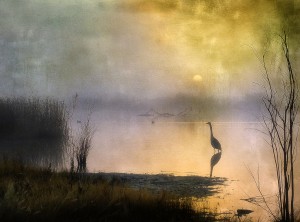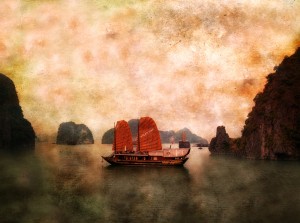
Having recently posted an essay on art photography’s trend away from the dominance of photons to the dominance of pixels (see my essay Of Comets and Pixels ) I suppose I shouldn’t have been surprised to see an exhibit so thoroughly given over to pixelography as was Dimensions in Texture. But I was.
The exhibit’s venue, Evan Anderman’s Journey Through Landscape gallery, generally features artists who, like Anderman himself, specialize in nature and travel photography. As a lot, N&T artists generally use Photoshop merely to touch up their photon-based images; they don’t usually use Photoshop to add pixels that co-star in the final image. For most of his multi-decade art career, Robert Schenkein has been an N&T photographer who has relied primarily on the skillful capture of photons by a light sensitive medium to create his art. So, yes, I was a bit surprised by Dimensions in Texture. Still, virtually no fine art photographer completely ignores digital technology these days, and ‘straight photography’ is now more a measure of the degree—rather than the religious abstention—of pixel mashing. In any case, my quibble with pixelography is not the art; it’s that the art is called ‘photography’. Regardless of the label I’d prefer to see attached to it, I think the art in this exhibit is lovely.
Dimensions in Texture consists of sixteen color inkjet prints, each approximately 16 inches on the long dimension and 12 inches on the short, framed in simple complimentary white frames. The tie that binds these prints is not so much the subject matter; the subjects fall in either the nature or travel category. Rather the common denominator, for all prints except one, is that the images have been ‘texturized’ by the digital blending-in of textured backgrounds. But the mere blending-in of textured backgrounds is not what makes this art so visually arresting. Like the Pictorialists of an earlier age of photography, Schenkein shows a fine gift for knowing which of his original photographs will work in this blended context. This is usually an image with an isolated subject as, generally, a busy scene relies on sharp detail to carry the image’s interest, and texturing tends to soften the details. Also like the Pictorialists of old, Schenkein displays a painter’s touch for image and color alterations that enhance the ethereal feeling that textured images can evoke. Of course, unlike the Pictorialists, who realized their art through physical manipulation of the negative and the colored gum bichromate print, Schenkein achieves his art by masterful Photoshop layering and color alteration.

The successful images in this exhibit—and most of them are—combine the ethereal effect of texturing with a scene that suggests a timeless narrative. The few images that didn’t have both elements working together can evoke bit of cognitive dissonance. For example, Halong Bay Junk, an otherwise otherworldly image of a Chinese junk afloat in waters surrounded by ancient limestone pillars, loses a bit of its charm because the junk is actually a tour boat, and its English name, Valentine, is clearly visible on its main sail. The timelessness of the image is lost in non-translation. Another image, Venice Clotheslines, is less successful because it was not textured like the other images in the exhibit. It is merely a photo (albeit of a visually interesting scene) of clothes hanging on a line to which the Photoshop watercolor filter has been applied. Hence the image does not achieve the sensual painterly look of the other fifteen images in the exhibit. Clotheslines is … dare I say it … hung out to dry, by itself. Since it really doesn’t fit in with the rest, the exhibit would be a bit more cohesive had Anderman and Schenkein not included it.
However, the less successful images are few; the majority of the images are a visual treat. I was particularly taken by Dawn’s Early Light. To capture the original photo on which the image is based Schenkein waited patiently in a pre-dawn fog bank for the sun to rise. When the sun rose across the water and the fog lifted a bit his patience was rewarded with a magical and timeless scene, a heron standing by the water’s edge. Schenkein’s deft touch with composition, texture blending, as well as with yellow, magenta, and cyan color alterations, results in a truly stunning image.
Call it pixelography, call it modern-day Pictorialism, or call it fine art photography. However it is labeled, Dimensions in Texture is very much worth seeing. Dimensions in Texture is at the Journey Through Landscape gallery through August 24, 2013.